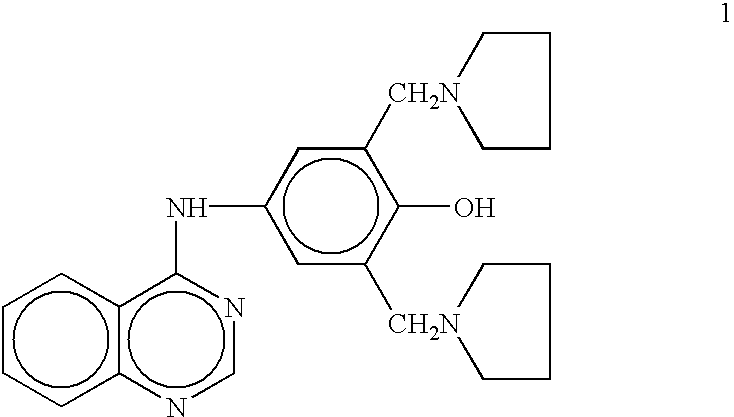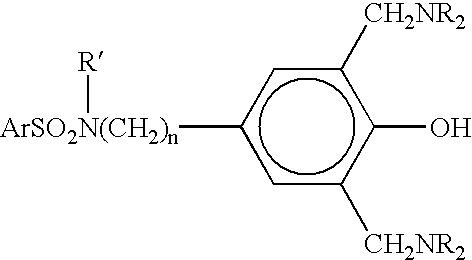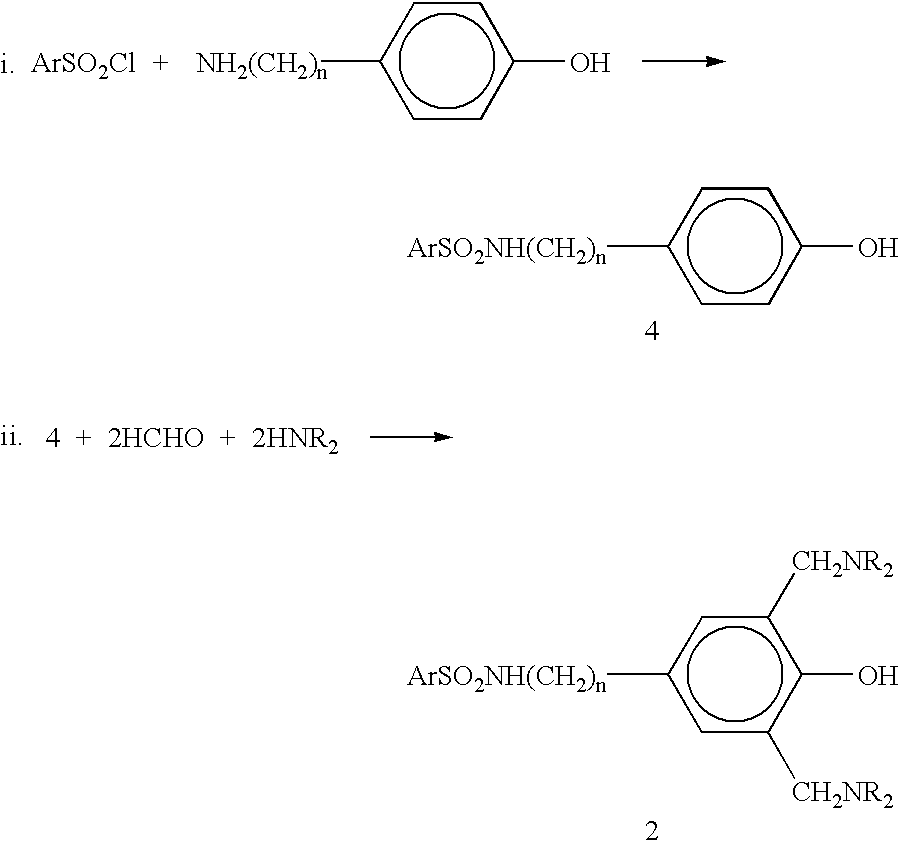N-substituted benzyl or phenyl aromatic sulfamides compounds and the use thereof
a technology of phenyl aromatic sulfamide and benzyl, which is applied in the direction of biocide, drug composition, cardiovascular disorder, etc., can solve the problems of gradual retrogression and reverse pigmentation of patients' skin
- Summary
- Abstract
- Description
- Claims
- Application Information
AI Technical Summary
Problems solved by technology
Method used
Image
Examples
example 2
N-[3,5-bis(1-Pyrrolidinomethyl)-4-hydroxy]phenyl-4-chlorobenzenesulfonamide (B-86810)
To a solution of 2,6-bis-(1-pyrrolidinomethyl)-4-aminophenol (1.3 g) in tetrahydrofuran (5 ml) was added dropwise a solution of 4-chlorobenzenesulfonyl chloride (1.0 g) in tetrahydrofuran (5 ml). The mixture was further stirred at room temperature for 4 hours. The solvent was removed in vacuo and the residue was dissolved in water. After being neutralized with 2N KOH solution, the mixture was extracted with ethyl acetate. The organic layer was successively washed with water and brine, dried over anhydrous Na.sub.2 SO.sub.4. After removing the solvent in vacuo, the residue was purified by silica gel column chromatography (eluted by CH.sub.3 COOEt:CH.sub.3 OH:NH.sub.4 OH=9:1:0.05). The resultant solid was recrystallized from ethyl acetate to give the titled product (1.3 g), mp 187-188.degree. C.
.sup.1 HNMR(CDCl.sub.3): 1.72-2.08(m, 8H), 2.56-2.88(m, 8H), 3.88(s, 4H), 6.90(s, 2H), 7.36(d, 2H), 7.64(d, ...
example 3
N-[3,5-bis(1-Pyrrolidinomethyl)-4-hydroxy]phenyl-N-ethyl-4-toluenesulfonamide (B-86809)
(1) To a stirred solution of lithium aluminum hydride (2.7 g) in tetrahydrofuran (25 ml) was added dropwise a solution of 2,6-bis(1-pyrrolidinomethyl)-4-acetamidophenol (5.6 g) in tetrahydrofuran (5 ml). The mixture was heated to reflux for 5 hours and was added dropwise water and aqueous 20% NaOH solution with cooling in an ice bath then was filtered by suction. The filtered cake was washed with tetrahydrofuran. The combined filtrate and washings were evaporated under reduced pressure to remove the solvent. The residue was purified by silica gel column chromatography (CH.sub.3 COOEt:CH.sub.3 OH: H.sub.4 OH=5:1:0.1) to give 2,6-bis(1-pyrrolidinomethyl)-4-ethylaminophenol (3.9 g).
.sup.1 HNMR(CDCl.sub.3): 1.16(t, 3H), 1.44-1.94(m, 8H), 2.24-2.66(m, 8H), 2.98(q, 2H), 3.52(s, 4H), 6.17(s, 2H).
(2) 2,6-Bis(1-pyrrolidinomethyl)-4-ethylaminophenol (2.6 g) and 4-toluenesulfonyl chloride (1.1 g) were dissol...
example 4
N-[3,5-bis(1 -Pyrrolidinomethyl)-4-hydroxyl]benzyl-4-chlorobenzenesulfonamide (B-87829)
(1) Triethylamine (0.77 ml) and 4-chlorobenzenesulfonyl chloride (1.2 g) were added to a solution of 4-hydroxybenzylamine (0.68 g) in ethanol(10 ml), respectively. The reaction mixture was stirred at room temperature for 4 hours and evaporated in vacuo to remove the solvent. The residual solid was washed with water then recrystallized from ethanol to give N-(4-hydroxybenzyl)-4-chlorobenzenesulfonamide (1.2 g), mp 187-189.degree. C.
(2) A mixture of N-(4-hydroxybenzyl)-4-chlorobenzenesulfonamide (0.74 g), pyrrolidine (0.68 ml) and 37% aqueous formaldehyde (0.85 ml) in ethanol (5 ml) was heated to reflux for 3 hours. The solvent was removed in vacuo and the residue was purified by silica gel column chromatography (CH.sub.3 COOEt: CH.sub.3 OH: NH.sub.4 OH=9:1:0.05).
The resultant solid was recrystallized from ethanol to give the product (0.84 g), mp 112-113.degree. C.
.sup.1 HNMR(CDCl.sub.3): 1.57-1.97(...
PUM
| Property | Measurement | Unit |
|---|---|---|
| Molar density | aaaaa | aaaaa |
| Fraction | aaaaa | aaaaa |
| Fraction | aaaaa | aaaaa |
Abstract
Description
Claims
Application Information
 Login to View More
Login to View More - R&D
- Intellectual Property
- Life Sciences
- Materials
- Tech Scout
- Unparalleled Data Quality
- Higher Quality Content
- 60% Fewer Hallucinations
Browse by: Latest US Patents, China's latest patents, Technical Efficacy Thesaurus, Application Domain, Technology Topic, Popular Technical Reports.
© 2025 PatSnap. All rights reserved.Legal|Privacy policy|Modern Slavery Act Transparency Statement|Sitemap|About US| Contact US: help@patsnap.com



